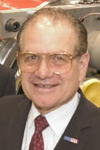Director's Corner
9 February 2006

Barry Barish
U.S. Budget News
In last week's column on the role of the GDE R&D Board (RDB), I made the statement that "the continuing and future R&D programs will be absolutely crucial for demonstrating critical elements of the design, optimizing it with respect to cost and performance, and finally evolving it as technologies improve, so that we can build the best possible machine when the ILC is constructed." I will expand on that statement today, especially in light of the good budget news from the U.S. The President's 2007 budget request to Congress includes a doubling of the ILC R&D budget from $30M to $60M. This is good news, indeed! Of course, this is just the beginning of the budget process in the U.S. and we will need to be equally successful in Congress when they act on the budgets later this year. (See today's In the News feature, "DOE FY07 Budget Request Has $775 Million for HEP" and slide 29 in the presentation given by Ray Orbach, Director of the Office of Science.)

Ray Orbach
The worldwide linear collider community has been focused on developing a global design for the ILC, ever since the choice was made to base the main linac on superconducting RF technology. To that end, ICFA created the GDE, and we are now almost six months old. During those six months much of our focus has been on determining a baseline configuration for the ILC. We recently accomplished that goal and documented it in our Baseline Configuration Document (BCD).
Much of our emphasis has now transferred toward organizing the design and costing effort, with a goal of producing a reference design by the end of 2006. It is natural that our focus has been on such short term goals, because we must all agree on the concept for the machine we want to build. We also need to get a reasonable idea of the design details, the costs and the possible trade-offs as soon as possible.
Nevertheless, the baseline is not yet the machine we will eventually want to build. Many of the decisions we made in creating the BCD were constrained by the need to design and cost the machine reliably this year. We can anticipate many improvements to our baseline design, as a result of a vigorous R&D program. Some revisions will lead to improvements in performance, some to reduced costs and others to reduced risk.
Such improvements to the baseline design will require significant increases in support for us to pursue the most promising ideas to the point where they could replace items in the present BCD. In addition, we need increased R&D support to optimize the designs, transfer them to industry, study specific sites for the machine, and to perform systems tests that will reduce the overall risks to the project.
A vigorous R& D program is essential to developing a robust design. I described last week how the GDE is working to develop a coherent and prioritized global R&D program that will minimize overlaps and cover the important areas. Increased U.S. funding represents a major step toward our being able to carry out such an R&D program, and one that will lead to an ILC construction project.